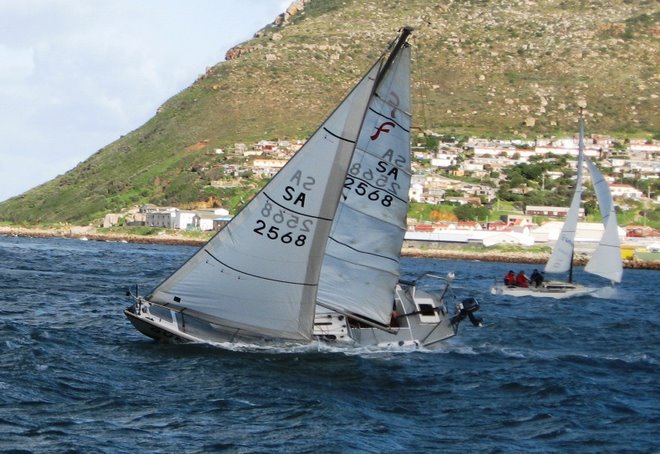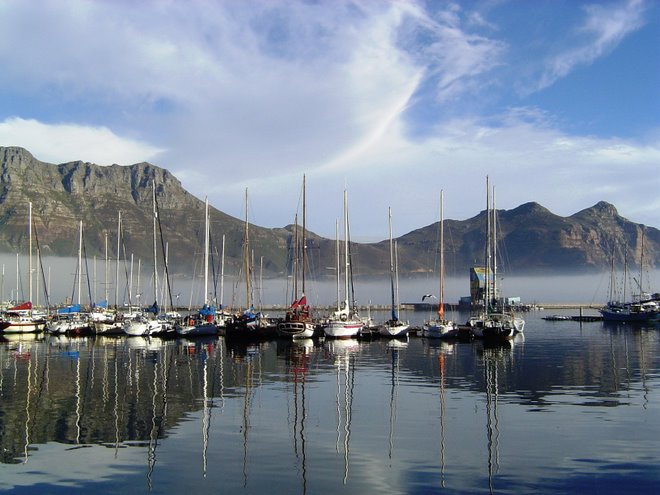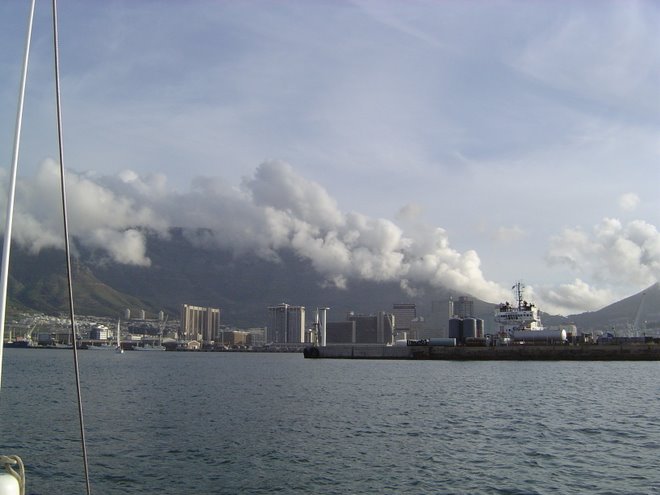 After delivering Quest to her new home in Hout Bay, I had good access to the boat which was now just a five-minute drive from my home. I was able to sail her and mess about with stuff to my heart's content. Initially we (my girlfriend Fiona and I) would take supper down to the boat and simply enjoy being on the water in the lovely Hout Bay marina. Next to all the big boats . . .
After delivering Quest to her new home in Hout Bay, I had good access to the boat which was now just a five-minute drive from my home. I was able to sail her and mess about with stuff to my heart's content. Initially we (my girlfriend Fiona and I) would take supper down to the boat and simply enjoy being on the water in the lovely Hout Bay marina. Next to all the big boats . . .But soon it became clear to me my appetite for boats and sailing was considerably more than most people I knew - perhaps verging on obsessive - or maybe even well past that . . . . To keep going - I resolved to start sailing singlehanded even though this didn't look like common practise in the keelboat community. Especially not when starting out. But then I had sailed dinghies singlehanded for years and this little keelboat seemed easier in some ways - at least if one could be well prepared - I thought. So a few weeks later I set off on my own - not without a few mistakes - eg forgot to disconnect the shorepower as I cast off etc. And then just as I was exiting the harbour mouth the outboard died on me! This was a bit alarming as I had a steady breeze blowing me onto the harbour wall, and no steerage. Managed to get the jib up very quickly and got just enough way on to steer out the harbour, which gave me a few minutes to attend to the outboard. Just a fuel supply problem, but a bit of a wake-up nevertheless. And then I hoisted the sails, recovered the fenders etc, and set off for a really nice sail of a few hours around the bay. No further problems - just had to be careful to stay ahead of the game - eg get the sails down before re-entering harbour etc, have lines at the ready etc. I had no autopilot, and no roller furling etc. Just the basics. Although this first experience was fine, I realised there was tons to learn to get this down to a polished and relatively safe operation. I made a nice checklist to place under the lazarette lid - including reminders to check fuel line was primed, halyards connected, fenders ready to be unclipped etc etc etc. I kept a few spare lines at hand, had a knife ready, lifejacket and harnesses ready, cellphone and flares within reach etc. And so it improved almost by each trip.
The challenge of single-handing soon became the focus of my sailing. I wasn't racing or anything - just trying to get everything working properly. This was enough - especially in Hout Bay which brings enough of its own challenges by way of extreme catabatic winds within its mountainous surrounds. Luckily the little boat lived up to its name and proved very seaworthy and equal to the conditions. It was designed by Oswald Berckemeyer - who also designed the famous Miura - all noted as excellent seaboats. The Flamenca - at 25' - is decidedly small - but displaces a respectable 2000 kgs, with low freeboard, moderate beam, and narrow stern. She clearly has impressive stability, and rides a big chop very well. No obvious handling problems or vices. To date, despite some very challenging weather, I have yet to have her mast in the water or even a broach.
So it's a safe, small boat, and actually ideal for single-handing. She is easily capable of 6-6.5 knots on a beat (given wind upwards of about 10 knots), and will hit about 7.5 knots reaching - according to my Garmin. Highest speed I have recorded is 10-12 knots surfing downwind on a broad-reach in about 35 knots, for periods of about ten seconds at a time. Not bad for a waterline length of 20.6', and a non-planing hull . . . So while not too fast - like these performance racing boats - she is safe and manageable. More recently I have raced her quite a bit - and she appears to be very equally matched with a Sadler 26. By chance more than foresight, I seemed to have ended up with a very appropriate design for my needs.
With my ambitions to get the boat optimised for singlehanding - the boat needed a few improvements and additions. Yes I am sure you can see the signs - since when have boats not been like large black holes devouring money and resources forever and ever - brought to an end only by bank managers, irate partners or simlar. Its a terminal condition I think - usually leading to further and bigger boats along the way too. And even if one can recognise the signs quite clearly, there's not much can be done about it. . . . .

So I added a few bits including a handheld GPS chartlotter, a boomcover, new mooring lines, anchors, cusion covers, a cooker, a wooden cockpit sole, new outboard, new safety equipment, new charts, almanacs. And then I added a tiller pilot, new anchors and lines. New running rigging. New standing rigging. New VHF radio too. Digital depthsounder. New battery. Electric bilge pumps. New manual bilge pump. Cupholders. Did I mention new sails, including a roller furling? Then a few barber-haulers for the jib-sheets. New windex and VHF aerial. Handheld VHF. Had the bottom scubbed down properly and well resealed. New stanchion bases and a spinnaker pole. New transom bracket for the outboard. New lifejackets with built-in harnesses. And a dinghy - nice inflatable canoe called a fishduck - you can get from www.ark.co.za. That sort of thing. Just a bit of maintenance really, or for safety. Plus I bought a marina berth but thats more like a real investment I think. Can't be too careful! Don't ask - yes it might be slightly over-capitalised by now - but I really needed all these things you see. In spite of all this - I have spent less than R100k all told (about 15k USD) - so less than the price of a small car.
So now the boat is reasonably well setup for singlehanding. The roller-furling headsail is a dream. Despite these things being a bit of a compromise - they make it faster for singlehanding as one can adjust sail to the conditions more readily. And its a nice tough sail that can be used
 in very strong wind - almost as a storm-jib. When racing - I keep it furled until the one-minute gun and then let it fly - so easy . . . .
in very strong wind - almost as a storm-jib. When racing - I keep it furled until the one-minute gun and then let it fly - so easy . . . .The autopilot has to be the most useful thing ever. Its a Raymarine ST2000 and probbaly a bit overspecced for my boat. But it works beautifully - never complains - and is just about as good as an extra pair of hands on the boat.
Personally - I really like the handheld chartplotter. Its a bit old by now - a Garmin GPS-V - but it holds all the SANHO charts ever made, and allows me to navigate with great confidence. I have all possible and likely routes plotted into it - including harbour entrances etc. Have used it a few times in anger - including a trip back from Cape Town once in very heavy mist - which simply wouldn't have been possible without it (or at least a GPS with routes loaded). I no longer am concerned with all the submerged rocks along the coast here - and I can the depths straight off the chart. I have linked it to my VHF (an ICOM M301) - which is a DSC set - and so I can send automatic Maydays with coordinates. Not sure who would hear them round here but its a nice idea.
The handheld radio is also great. Far more practical than the fixed set - its an ICOM M-71. Great for racing or short-range comms - and comes with me on the dinghy etc.
The new outboard is also a good thing. Its a Yamaha 5Hp 2-stroke. Far lighter than the original 8Hp Mariner (which was nationalised by some local truants I think) - it is far easier to lift on and off the transom - at about 25kgs. It also has the benefit of having an integral header fuel tank - which is more reliable than the long feeder tube which runs a long way down into the lazarette and often caused problems . . . It is super economical - a recent trip from Simonstown used only 10l for 80km of motoring - at around 4.8 knots.
So by now I have done a fair bit of singlehanding - including the weekly club racing, our recent Admiral's Regatta over three days, and two trips to-from Cape Town. I have sailed in pretty lively conditions with winds up to 45 knots (see posting on "The Big Blow"), and many other fresh conditions. Singlehanding is a particular challenge, and for my money, perhaps the most enjoyable way to sail, on the right boat.





